Partisan
Resistance in Belarus during World War II
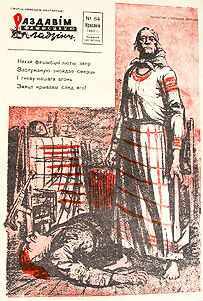 The tragedy that Belarusian people have undergone during World War II is so
deep that even today this topic is embedded in everyday surrounding and culture
of Belarusians. After 60 years of peaceful life, Chernobyl, dismantling of the
USSR, 14 years of sovereignty still WWII remains a major emotional rift in Belarusian soul. For
60 years
after WWII BelarusFilm - the main Belarusian movie studio - was making movies
centered on WWII Belarusian tragedy, to such an extent that some have jokingly
renamed it into PartisanFilm. Even this year the two major Belarusian movies that came
out - both State sponsored and independent movie, forbidden in Belarus - are dealing with
WWII and Belarusian partisans. The literary heritage of the beloved Belarusian
writer - Vasil' Bykau, referred by many as consciousness of Belarusian nation -
was centered entirely on WWII. The march of ever diminishing number of the WWII
veterans in Minsk every May 9 is a cherished national event televised not only
in Belarus, but in many neighboring states. The WWII topic is too difficult
emotionally and for years I was avoiding to write about it in the Virtual Guide
to Belarus. Even now I shall probably restrict it to dry statistics as I write
these lines on a sunny Californian Saturday of July 24, 2004 with a lump in my
throat.
The tragedy that Belarusian people have undergone during World War II is so
deep that even today this topic is embedded in everyday surrounding and culture
of Belarusians. After 60 years of peaceful life, Chernobyl, dismantling of the
USSR, 14 years of sovereignty still WWII remains a major emotional rift in Belarusian soul. For
60 years
after WWII BelarusFilm - the main Belarusian movie studio - was making movies
centered on WWII Belarusian tragedy, to such an extent that some have jokingly
renamed it into PartisanFilm. Even this year the two major Belarusian movies that came
out - both State sponsored and independent movie, forbidden in Belarus - are dealing with
WWII and Belarusian partisans. The literary heritage of the beloved Belarusian
writer - Vasil' Bykau, referred by many as consciousness of Belarusian nation -
was centered entirely on WWII. The march of ever diminishing number of the WWII
veterans in Minsk every May 9 is a cherished national event televised not only
in Belarus, but in many neighboring states. The WWII topic is too difficult
emotionally and for years I was avoiding to write about it in the Virtual Guide
to Belarus. Even now I shall probably restrict it to dry statistics as I write
these lines on a sunny Californian Saturday of July 24, 2004 with a lump in my
throat.
1930-ies in Belarus and generally in USSR weren't the happiest years.
Stalinist doctrine grew, millions of people were prosecuted by NKVD.
Fear and suspicion were nesting in every house. "Black crows" - the NKVD
black cars were coming to the houses of your neighbor to pick him up in the
midst of night, only to never see him again. The forced organization of collective farms
- kolkhozes - from individual peasant families sparked many conflicts and resulted in many victims. 1937 was written into the
history of USSR as perhaps the bloodiest year ever. Millions of executions were
performed in a permanent hunt of traitors and "inner enemies". Several years
before Khatyn executions by Hitler Germany
horrible Katyn'
and Kurapaty executions by Stalin's USSR
took place. In 1939 Germany and USSR have struck Molotov-Ribbentrop
Pact in which they divided Eastern European lands lying between them -
Western Belarus, Western Ukraine and Baltic states were occupied by USSR. The
repressions against Poles and anti-communists on the occupied areas were a
background in which Belarus has arrived into 1941.
It is not surprising that when Germans attacked USSR (Belarus) on June 22,
1941 the response of local population was more than ambivalent.
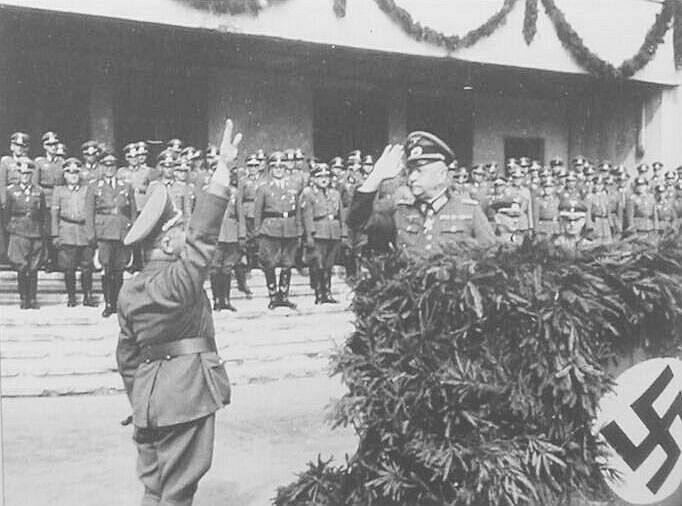
Generalkommissar
Wilhelm Kube (left) receives power as a head of newly formed Minsk German
administration, August 31, 1941. When Kube was killed by Minsk underground
resistance in 1943 Germans have killed 1,000 hostages - citizens of Minsk - in retaliation.
Some people tried to retreat further into USSR, whereas others met Germans with flowers
in their best clothes with hope of liberation from Stalin repressions. It is at
that time a wide collaboration
movement emerged in Belarus. Estimated 120,000 Belarusians have collaborated
(willingly or unwillingly) with Nazi.
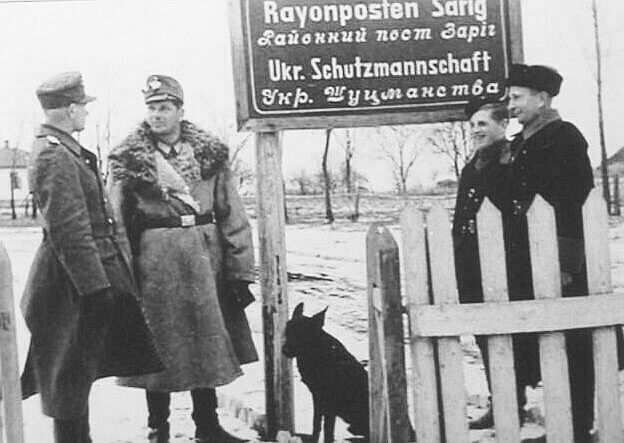
German
officers and Ukrainian Collaborationist police in Sarig, near Kiev, Ukraine -
1942
After a decade of experiencing prosecution of everything Belarusian as
"bourgeois" Belarusian nationals hoped to
exploit the occupation as an opportunity to re-built Belarusian nation. A
"Second All-Belarusian Congress" in 1944 has even proclaimed sovereign
Belarusian State in July 1944, against German will. One must recollect here that the first
Belarusian state in the new history - Belarusian
Democratic Republic (BDR) - was created in the years of German occupation of
Belarus during WWI in 1918 by the "First All-Belarusian Congress". Radaslau
Astrouski, who led Belarusian national movement during WWII was actually
member of the government of BDR in 1918. Many of these nationalists have turned
anti-Semitic because of their belief in Jewish
origins of Bolshevism. But even the
most hardcore nationalists were affected by horrible massacres of Belarusian
Jewry, tortures and cruelty with captured Red Army POWs and mass executions of general population.
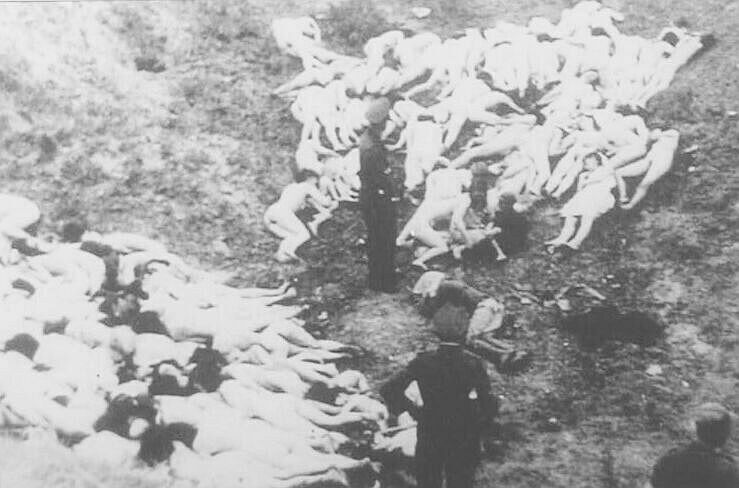
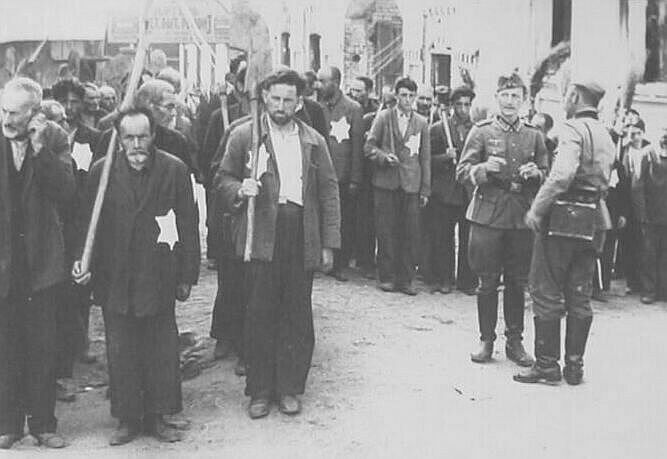
Execution of women
and children near Mizoch, October 14, 1942. Jewish work column - Mahilyow,
1941.
Himmler has pronounced a plan according to which 3/4 of Belarusian population
was designated to "eradication" and 1/4 of racially cleaner population
(blue eyes, light hair) would be allowed to serve Germans as slaves. Mass executions of entire villages
were a common Nazi practice. While
initially Germans allowed peasants to take cattle from kolkhoz, later all this
cattle was loaded on trains and shipped to Germany. Many Belarusian youth
were shipped to Germany as slaves.
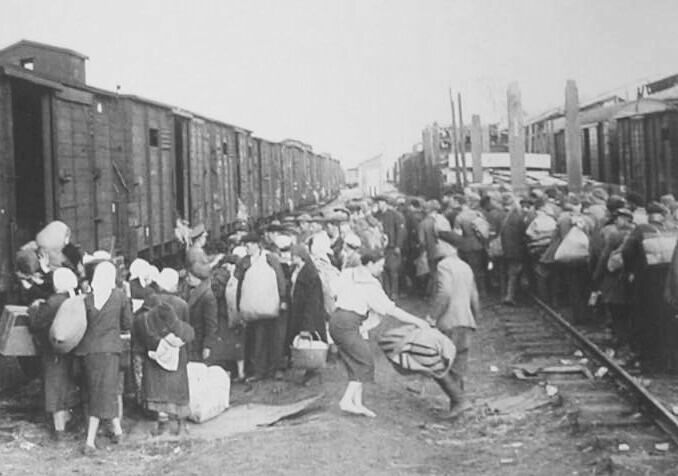
Young Belarusians
shipped to Germany as forced laborers, 1942.
By Summer 1942 the sentiments in Belarusian population were strongly
anti-Nazi. It is at this time a serious partisan and underground resistance
fight brakes out on the occupied territory in Belarus. Already in the Summer of 1941
approximately 12,000 of Belarusian partisans have conducted military operations against
German occupants. At that time the partisan forces were comprised mostly of Red
Army soldiers that escaped surrounding or from German captivity. By January 1,
1943 there were 448 Belarusian partisan detachments and 64 diversion groups.
They counted approximately 58,000 partisan fighters. At the same time Ukraine
with 4 times larger population than Belarus had 68
partisan detachments with 9,000 people in them. Smaliensk region of Russia just
East
of Belarus had counted 120 partisan detachments and 9 diversion groups - 10,000
people total.
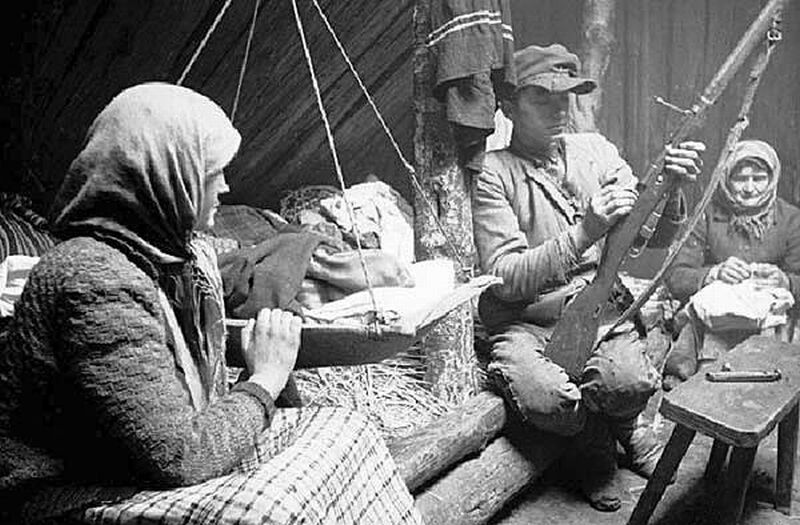
Belarusian
partisan in a forest dugout with his family, 1944
While majority of the partisan and underground movement was driven by
a heroic effort of Belarusian people to liberate their homeland from Nazi, there
were also negative things associated with some partisan detachments. The rumors
about crimes of partisans have always existed in Belarus. Common villagers were
often as scared of Soviet partisans as they were of Nazi. In an effort to protect
the villages from both some village leaders have become double agents of both
Nazi and Partisans. Clearly majority of partisans were not able to fight and
feed themselves simultaneously, and so many times they forced Belarusian villagers to give up
their food supplies and cattle. This would in term put villagers in mortal danger from Germans,
since they could be identified as collaborators to partisans.
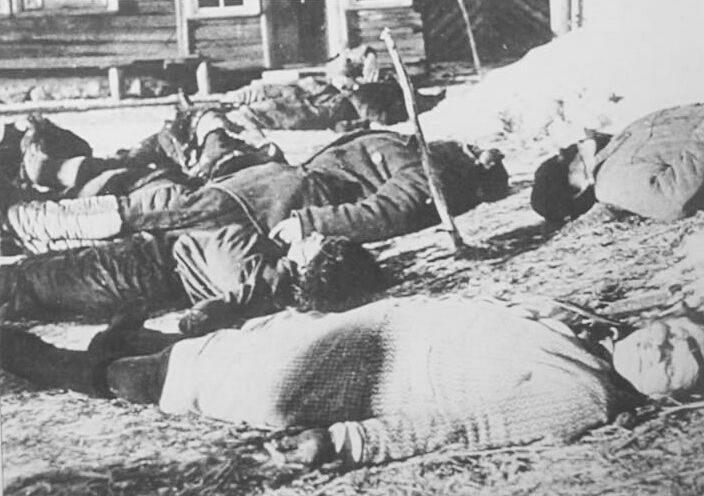
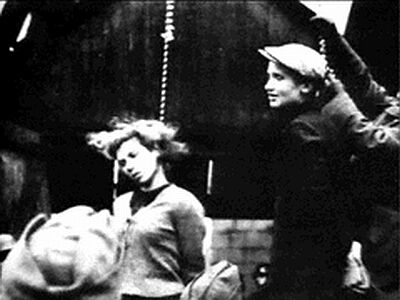
Victims
of Anti-Partisan Punishment Operation - Minsk region, 1943. 17y.o. Belarusian
Jewish (Masha Bruskina 17y.o. Jewish partisan on the left) partisans public hanging by Nazi.
The standard of SS practice was to execute entire population of the
village near which partisan attack has occurred in retaliation. More than 600 villages like Khatyn
were burned by Nazi with their entire population. Not
all partisan detachments had pristine morals - tyranny of commanders, heavy
drinking, anarchy, looting of food and clothing, even rape - were reported. These
actions were known to happen in partisan detachments of Lunin, Charkasau, group
of Muhin. The head of Central Headquarters of Partisan Movement - Brigade Commissar
Konkin called partisan detachments of Miciuhin and Zaharau "bandit
formations". The recent independent feature film Mysterium
Occupation, which is forbidden today in Belarus as "distorting
historical truth", is delivering exactly this taboo information about
partisan movement in Belarus. In many senses society governed by Communist
totalitarian regime of Stalin in 1930-ies was already militarized and had
established discipline of fear. And so, the development of the network of 1,200 Communist
Party cells within partisan detachments around 1943 has considerably improved
discipline and cleaned the
situation.
1943 was a year of unprecedented Belarusian partisan battle against Nazi. Over the
period of 1418 days of German occupation of Belarus 1,255 partisan detachments
were formed and lead military actions in Belarus with 374,000 fighters.
Additionally approximately 400,000 of locals supported partisan movement.
In the cities 70,000 people were involved in the underground resistance. During
the three years of war on occupied territory of Belarus (June 1941 - July 1944)
Belarusian partisans and underground resistance fighters have killed or
incapacitated more than 500,000 of
Nazis. 11,128 of German trains following to Russian East Front, as well as 34
armored battle trains were blown up or derailed by Belarusian partisans. 29 railway stations, 948
Military Headquarters, 18,700 cars and trucks, 819 railway and 4,710 auto
bridges were destroyed by Belarusian partisans. The partisan movement was so
overwhelming that in 1943-44 there were large regions in occupied Belarus, where
Soviet rule was established deep inside the German occupation territory. The
fully functioning partisan kolkhozes were farming and growing cattle to support
partisans.
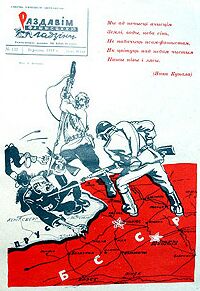
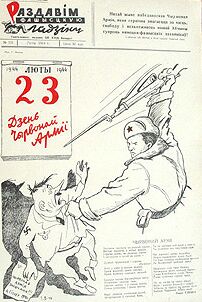
Pages
of the Moscow propaganda newspaper published for Belarusian partisans
"Squish the Fascist Beast". Interestingly in an effort to appeal to
Belarusian patriotism it is all published in Belarusian - the very language that
was prosecuted by Soviets just before WWII and is prosecuted
by Lukashenka regime in today's Belarus.
The most known partisan detachments acting in Belarus were led by U.E.
Labanok, R.N. Machul'ski, K.S. Zaslonau, V.I. Kazlou, V.Z. Korzh, K.T. Mazurau,
M.V.Zimianin, P.M. Masherau. Many of these commanders have become party and
government leaders of Byelorussian Soviet Socialist Republic after WWII.
Over 500,000 Belarusians were drafted in the Red Army during
1941 retreat. Overall 1.3 million Belarusians fought in Red Army against
Nazi, including 194,000 partisan detachment members, who enlisted after
liberation of Belarus in 1944.
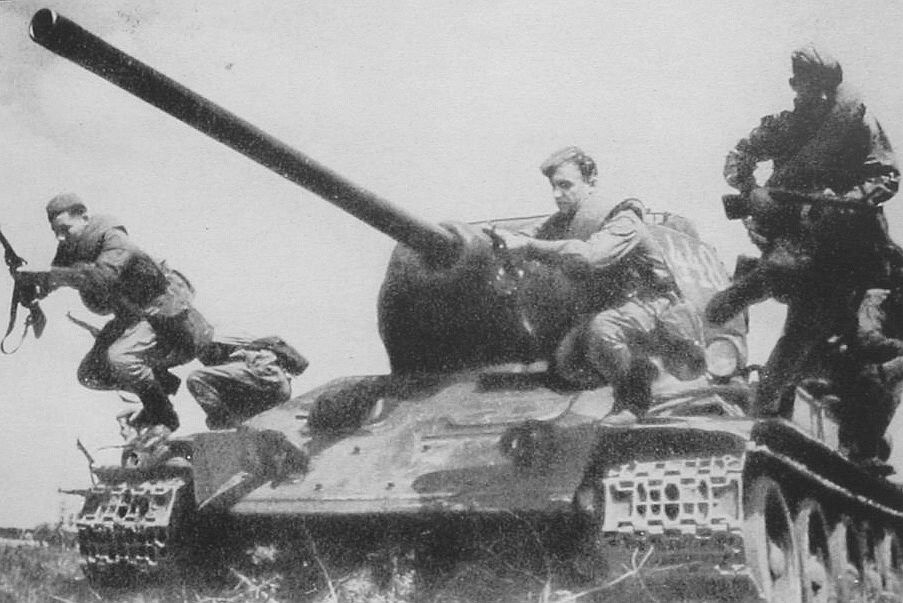
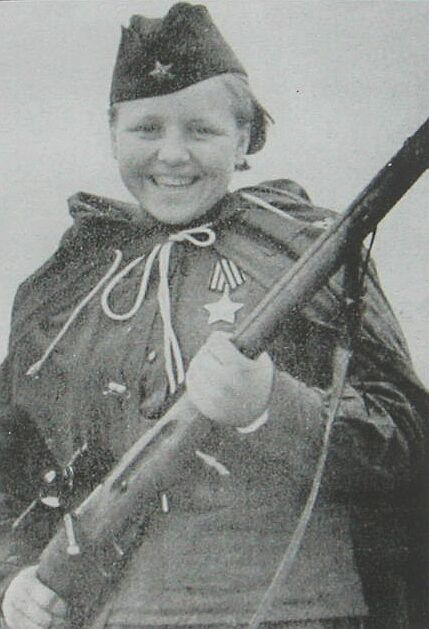
Red
Army infantry attack supported by T-34 tank. Red Army woman-sniper in Belarus,
July 1944
Belarusians have received over 300,000 combat Orders
and Medals for the courage in the battles of WWII. 396 Belarusians received the
USSR highest military reward - the golden star of the Hero of the Soviet Union. Four Belarusians -
P.Ya. Halavachou, I.I. Husakouski, S.F. Shutau and I.I.Yakubouski - were honored
the title of the Hero of Soviet Union twice. 63 Belarusians became Cavaliers of
Order of Glory of all three stages. Belarusian partisans and underground
resistance members received 140,000 combat orders and medals during the WWII.
88 of them have become Heroes of the Soviet Union for heroic deeds.
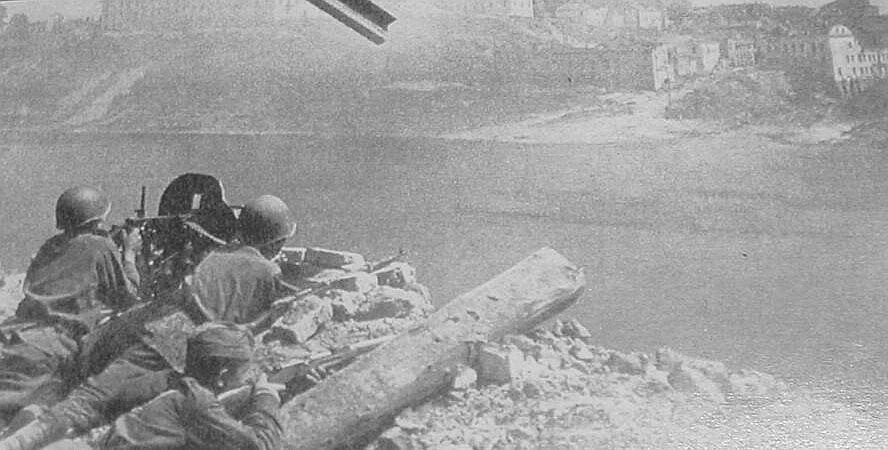
Red
Army soldiers liberating Belarusian City, 1944
The USSR did not join Geneva convention in 1929. This convention was
signed even by Germany in 1934. It is hard to guess what strange ideas governed
Stalin - a dictator of the USSR at that time - in not signing the convention.
The official pretext was that Geneva Convention does not go far enough in protecting POWs.
But most likely Stalin did not expected anyone to become a prisoner. He treated
all Soviet POWs as traitors. Because of this Red Army POWs were not supervised by International Red Cross or
any international organizations and were treated by Nazis many times worse than Western
allies. Millions of Soviet POWs and Belarusian forced laborers transported to Germany have paid for this Stalin's
attitude with their suffering, tortures and often lives.
Even worse, on their return to the USSR they were met with suspicion, NKVD
interrogations, treated as traitors and deserters. Many of them served long
times (25 years was the usual term) in Stalin's Gulags in Siberia.
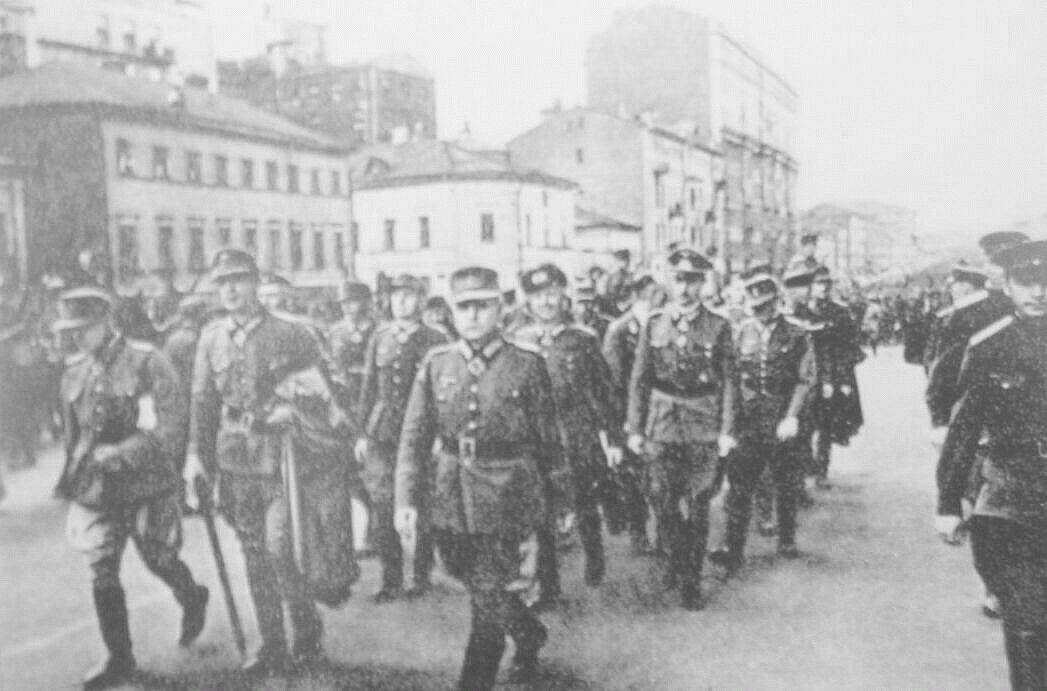
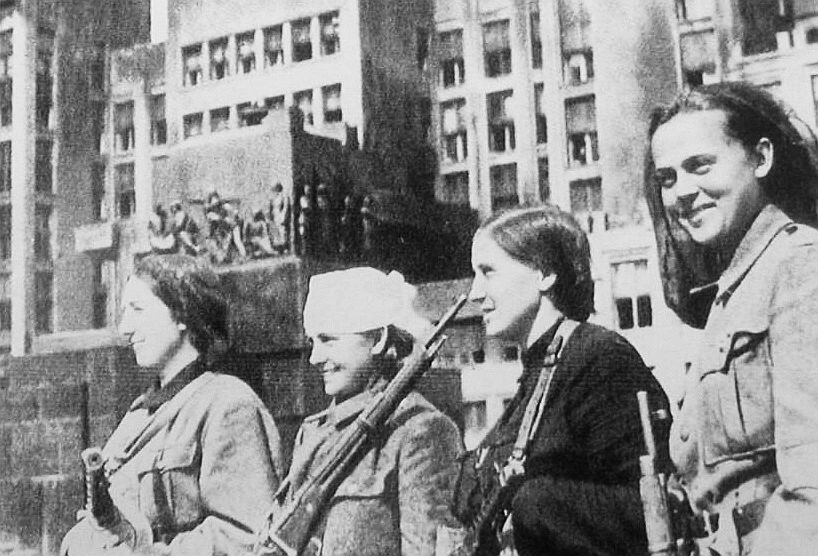
German
POWs marched by Red Army through Belarusian city. Four women partisans in
liberated Minsk, 1944.
Different statistics are given for the number of WWII victims in Belarus.
The situation is distorted by the secret Stalin's mass executions that occurred
in Belarus few years before the war. It is now a common belief that every forth
citizen of Belarus has perished in the World War II, reaching every third in
some regions (Vitebsk region). Per capita Belarusians lost more lives during
WWII than any other nation. The Nazi occupation forces were responsible for 2.2
Million Belarusians dead, while 380,000 young Belarusians were sent to Germany
for forced labor - "Ostarbeiters". Some
recent reports raise the number of Belarusians who perished in War to "3
million 650 thousand people, unlike the former 2.2 million. That is to say not
every fourth inhabitant but almost 40% of the pre-war Belarusian population
perished (considering the present-day borders of Belarus). "
The material losses of Belarus reached 75 Billion Rubles, which equals to
35 annual state budgets of Belarus of 1940. More than 209 cities and towns (out
of 270 total),
9,000 villages were destroyed. 10,000 industrial enterprises were either
destroyed or evacuated to Germany. The capital of Belarus was ruined by bombings
to such extent that for a while it was considered more reasonable to build it in a
different place. But emotions took over reason and Minsk was re-built in it's old
place, just as entire Belarus was. In about 5 years after war Belarus was
rebuilt and Belarusian industry exceeded pre-war levels through an
extraordinary effort of the youth delegated by other Soviet Republics of the
USSR. Many of those delegates settled in Belarus and were quite
disturbed by the rising nationalism in Belarus of the early 1990-ies. But amidst the
hurricane of ethnic conflicts that swept Eastern Europe and former USSR
republics in 1990-ies Belarus was the only former soviet republic that has never
lost one human life to ethnic differences.
Over the centuries of our bloody history Belarusians have learned that Peace is
a #1 priority of Life...
References used in this page:
- "Bolshevik System of Power in Belarus" ("Bal'shavickaia
sistema ulady na Belarusi") by M. Kasciuk, Minsk - 2000, Publishing
house "Ekaperspektyva". ISBN 985-6102-30-8
- This is the main source used in this page. It gives perhaps most
balanced picture on the WWII events and partisan struggle in Belarus.
- "Belarus. From Soviet Rule to Nuclear Catastrophe" by
David R. Marples, New York - 1996, Publishing house "St. Martin's
Press". ISBN 0-312-16181-6
- "Collaboration in the Holocaust. Crimes of the Local Police in
Belorussia and Ukraine, 1941-1944" by Martin Dean, New York -
2000, Publishing house "St. Martin's Press" ISBN 0-312-22056-1
- "Belorussia 1944. The Soviet General Staff Study" ed.
David M. Glantz, Harold S. Orenstein, London-Portland, Or - 2001, Publishing
house "Frank Cass" . ISBN 0-7146-5102-8
Related Links:
- La
Resistenza Partigiana in Belarus (In Italian)
This page covers partisan
resistance in Belarus during WWII and has an interesting photogallery of histarical
photos of WWII. The page is run by an Italian Chernobyl charity - Progetto
Humus.
- History
of Belarus @ World IQ
Since the early days of the occupation, a powerful and increasingly
well-coordinated partisan movement emerged. Hiding in the woods and swamps,
the partisans inflicted heavy damage to German supply lines and
communications, disrupting railway tracks, bridges, telegraph wires,
attacking supply depots, fuel dumps and transports and ambushing German
occupation soldiers. In the greatest partisan sabotage action of the entire
Second World War, the so-called Osipovichi diversion of 30 July 1943, for
instance four German trains with supplies and Tiger tanks were destroyed. To
fight Soviet partisan activity, the Germans had to withdraw considerable
forces back behind their front line.
- "Partisan
War" - an article by "Moscow Times" about recent
Belarusian independent movie - "Mysterium Occupation":
Occupied by various powers throughout its history, Belarus has plenty of
painful memories connected with the World War II period, during which a
quarter of its population died, and its aftermath, when thousands more were
sent to Soviet labor camps on charges of collaboration. Indeed, much of the
country's national mythology is tied to those experiences
- How
many Belarusians perished during the war? an article at Open.by
The ESC's report stresses that 810,091 military prisoners were
killed and tortured to death on the Belarusian territory. We do not have to
forget that the most part of them were not Belarusians or natives of the
republic. For some reasons, for 54 years this number had been representing
the considerable part of Belarus' demographic losses. It results,
according to incomplete data, that demographic losses of Belarus during the
war amounted to 3 million 650 thousand people, unlike the former 2.2
million. That is to say not every fourth inhabitant but almost 40% of
the pre-war Belarusian population perished (considering the present-day
borders of Belarus). Of course, this problem requires further investigation
and it is too early to put the final point in this case.
- A
Partisan's Story
By Boris Kozinitz, Dokshitz-Tel-Aviv
When we neared the monastery which was only 200 meters from the
ghetto gate, we talked to Sagalchik about freeing the ghetto. According to
the plan we were supposed to take from the ghetto only men vital to us: A
doctor with his equipment; medicines; the dentist Simchelevitch and others,
but with Sagalchik we talked about freeing the whole ghetto.
- WWII
Pictures of Simon Wiesenthal Center.
Bear in mind, when they say Russians they most likely refer to Belarusians.
- Republic-Partisan
- an article in Russian in "Sovetskaia Rossia" about Partisan
Movement in Belarus.
This is already more modern interpretation of partisan war in
Belarus, slightly departed from Soviet black&white doctrine
- Eurozine:
Between brotherly Russia and peaceful Europe by Andrej
Dynko
The Belarusians consider peace to be the highest value. The notorious
phrase, "Anything rather than war," is the basis of their
political behavior. In the period between the 1950s and 1980s, Belarusian
culture created a rich pacifist tradition. A humanistic message was
contained in fine art masterpieces such as Mikhas Savitski's Partisan
Madonna. Even mass culture could not avoid the anti-war theme. A lot of
pacifistic songs appeared. "We want the peaceful sky not to know the
fire of war... We wish friendship and sincere brotherly love to
peoples," - these are lines from the unofficial anthem "Radzima
Maya Darahaya" (My Dear Motherland), the tune of which serves as the
station designator of Belarusian Radio. Literature, whose role was extremely
important in society at that time, was the determining factor in creating
the pacifistic sentiments. Essays by Ales Adamovich, novels by Vasil Bykaw
and Ivan Shamyakin gained prominence for their deromanticization of warfare.
Pacifism and tolerance were questioned by none of the more or less
significant authors of that time. The presence of this theme in works of art
was even intrusive. The authorities tolerated that pacifism. In Soviet
Belarusian culture, it was one of the manifestations of conformism, a
substitute for open dissent, upon which nobody among the front-rank figures
of Belarusian culture ventured. That pacifism was so popular and consistent
that it became one of the cultural and political canons and turned into a
consciousness-determining phenomenon. Pacifism harmonized with the historic
memory of people and came from previous cultural traditions. Incidentally,
the influence of high culture, in particular literature, on the formation of
the Belarusians' consciousness in the Soviet era is frequently
underestimated, above all because change has now occurred in the methods of
mass communication. For it is no longer the written word but sight and sound
that dominate the communications industry. Anyway, pacifism and the
propagation of tolerance in the Belarusian culture of the Soviet era are
worth of certain consideration. The replacement of the first lines of the state
anthem, "We, Belarusians, with brotherly Russia," for "We,
Belarusians, are peaceful people," which was initiated by
Alyaksandr Lukashenka, on the surface looked like the result of search for a
solution that would insult nobody. But this choice in fact reveals the
intuition and opportunism generally characteristic of Lukashenka's political
style
 This file is a part of
the Virtual Guide to Belarus - a collaborative project
of Belarusian scientists and professionals
abroad. VG brings you the most extensive compilation of the information about Belarus on
the Web.
This file is a part of
the Virtual Guide to Belarus - a collaborative project
of Belarusian scientists and professionals
abroad. VG brings you the most extensive compilation of the information about Belarus on
the Web.
Please send your comments to the authors of VG to
Belarus 
History | Statehood | Culture | Law and
Politics | Cities | Nature and Geography | Travel | Global Resources | Dictionaries | Chernobyl | Genealogy | Industry | New
©1994-04 VG to Belarus
Disclaimer
 The tragedy that Belarusian people have undergone during World War II is so
deep that even today this topic is embedded in everyday surrounding and culture
of Belarusians. After 60 years of peaceful life, Chernobyl, dismantling of the
USSR, 14 years of sovereignty still WWII remains a major emotional rift in Belarusian soul. For
60 years
after WWII BelarusFilm - the main Belarusian movie studio - was making movies
centered on WWII Belarusian tragedy, to such an extent that some have jokingly
renamed it into PartisanFilm. Even this year the two major Belarusian movies that came
out - both State sponsored and independent movie, forbidden in Belarus - are dealing with
WWII and Belarusian partisans. The literary heritage of the beloved Belarusian
writer - Vasil' Bykau, referred by many as consciousness of Belarusian nation -
was centered entirely on WWII. The march of ever diminishing number of the WWII
veterans in Minsk every May 9 is a cherished national event televised not only
in Belarus, but in many neighboring states. The WWII topic is too difficult
emotionally and for years I was avoiding to write about it in the Virtual Guide
to Belarus. Even now I shall probably restrict it to dry statistics as I write
these lines on a sunny Californian Saturday of July 24, 2004 with a lump in my
throat.
The tragedy that Belarusian people have undergone during World War II is so
deep that even today this topic is embedded in everyday surrounding and culture
of Belarusians. After 60 years of peaceful life, Chernobyl, dismantling of the
USSR, 14 years of sovereignty still WWII remains a major emotional rift in Belarusian soul. For
60 years
after WWII BelarusFilm - the main Belarusian movie studio - was making movies
centered on WWII Belarusian tragedy, to such an extent that some have jokingly
renamed it into PartisanFilm. Even this year the two major Belarusian movies that came
out - both State sponsored and independent movie, forbidden in Belarus - are dealing with
WWII and Belarusian partisans. The literary heritage of the beloved Belarusian
writer - Vasil' Bykau, referred by many as consciousness of Belarusian nation -
was centered entirely on WWII. The march of ever diminishing number of the WWII
veterans in Minsk every May 9 is a cherished national event televised not only
in Belarus, but in many neighboring states. The WWII topic is too difficult
emotionally and for years I was avoiding to write about it in the Virtual Guide
to Belarus. Even now I shall probably restrict it to dry statistics as I write
these lines on a sunny Californian Saturday of July 24, 2004 with a lump in my
throat. 














